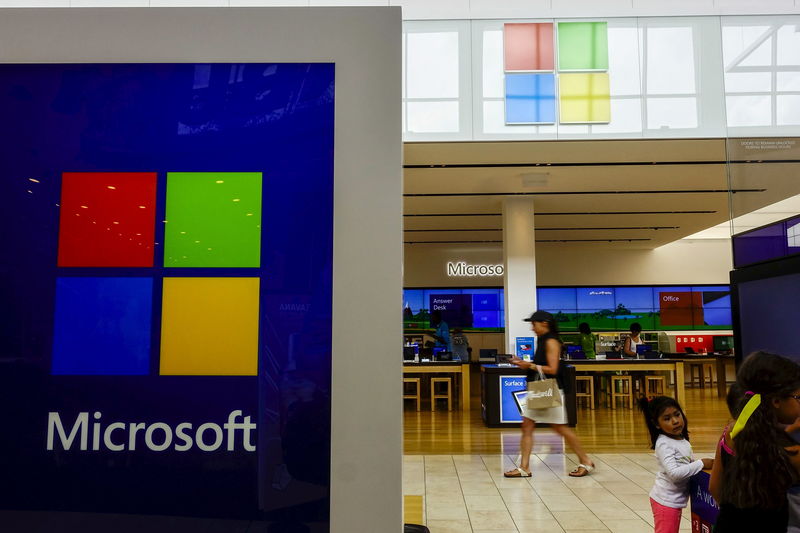By Peter Nurse
Investing.com -- The dominant tech sector is set to power Wall Street higher, with Microsoft (NASDAQ:MSFT) and Google parent Alphabet (NASDAQ:GOOGL) producing more healthy quarterly numbers after the close Tuesday. The U.K. is likely to introduce a new spending plan at the annual budget, while the Bank of Canada holds a policy-setting meeting. Additionally, crude weakens as U.S. stocks increase. Here's what you need to know in financial markets on Wednesday, 27th October.
1. Tech giants continue to shine
Results from the tech giants, which have driven a lot of the substantial gains on Wall Street over the last year or so, continue to impress.
Fresh off Monday’s healthy data from Facebook (NASDAQ:FB), both Microsoft and Alphabet, the owner of Google, released strong quarterly numbers after the close Tuesday.
Software giant Microsoft beat expectations for its first quarter, boosted by strong revenue growth for Azure, the company's flagship cloud-computing business.
The firm's other business units - Windows software, the Teams messaging service and LinkedIn professional social networking platform - also put in positive performances.
Turning to Alphabet, its Google unit reported higher than expected third-quarter ad sales, rising 41% to $53.1 billion in the quarter. Demand for its services surged in the past year as the pandemic forced people to spend more time online, and these new habits have persisted.
The company's quarterly profit was just short of $19 billion, marking a third-straight quarter of record profit.
2. U.K. budget to introduce new spending plan
U.K. Chancellor Rishi Sunak is set to unveil his latest annual budget later Wednesday, and is expected to loosen the purse strings as he tries to move the country away from the pandemic-induced downturn.
The U.K. Treasury has already stated, via email on Monday, that the public sector pay freeze will come to an end next year, citing a “solid economic recovery and encouraging signs in the labor market.”
While Sunak is set to keep a tight grip on the day-to-day spending by the various government departments, given the country’s massive budget deficit, he is also expected, at 1130 GMT, to announce a three-year spending plan to boost investment in public transport and skills training.
This boost in spending is likely to be made possible by an upgrade of Britain's growth forecasts, providing the government with extra room for manoeuver.
3. Stocks to edge lower; Earnings season continues
U.S. stocks are set to open marginally lower, retreating from record levels, with the focus on strong results from tech giants Microsoft and Alphabet (see above).
By 5:15 AM ET, Dow Jones futures were down 23 points, or 0.1%, S&P 500 futures were down 4 points, or 0.1%, and Nasdaq 100 futures were effectively flat.
The blue-chip Dow Jones Industrial Average and the broad-based S&P 500 both closed at record highs the previous session, helped by a broadly positive earnings season.
So far roughly 30% of the S&P 500 has reported earnings. Of these companies, 82% have topped earnings expectations and 80% have exceeded revenue estimates.
The tech sector takes a rest Wednesday, but there are results due from the likes of Coca-Cola (NYSE:KO), McDonald’s (NYSE:MCD), Boeing (NYSE:BA), General Motors (NYSE:GM) and Harley-Davidson (NYSE:HOG) before the market opens.
4. Bank of Canada to continue to taper
The Bank of Canada holds its latest policy-setting meeting later Wednesday, and is widely expected to continue reducing its weekly government bond purchases, reining in the quantitative easing program that has supported the country’s financial system since the start of the pandemic.
This would be the fourth time over the past year the central bank has rolled back this program, feeding expectations that it will start increasing interest rates as soon as next year.
The markets are pricing in four rate hikes next year as inflation has climbed well above the Bank of Canada’s 1%-to-3% control range.
5. Crude slips as U.S. inventories grow
Oil prices weakened Wednesday after U.S. crude oil stockpiles rose more than expected last week, suggesting stagnating demand in the world's largest oil consumer.
By 5:15 AM ET, U.S. crude futures were down 1.7% at $83.22 a barrel and Brent futures dropped 1.3% at $84.53 a barrel, both contracts retreating from recent multi-year highs.
Data released late Tuesday from the industry-funded American Petroleum Institute showed that crude oil inventories rose 2.3 million barrels in the week ending Oct. 22, more than the expected 1.9 million-barrel gain.
Official data from the U.S. Energy Information Administration is due to be released later Wednesday.
